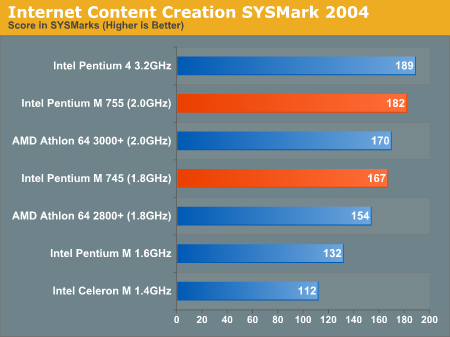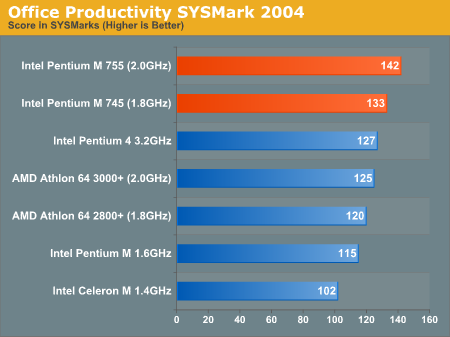Intel's 90nm Pentium M 755: Dothan Investigated
by Anand Lal Shimpi on July 21, 2004 12:05 AM EST- Posted in
- CPUs
General Usage Performance - SYSMark 2004
Like the Winstone tests, SYSMark is an important suite to look at as this is how most users will use their notebooks. Just like Winstone, SYSMark is divided into both office and content creation suites; let's have a look.This time, we look at content creation performance first. Here's what happens with the Internet Content Creation suite:
"In this scenario, the content creator creates a product-related website targeting a broadband and narrowband audience. The user first renders a 3D model to a bitmap, while preparing web pages using a web site publishing tool. The user opens a video editing package, creates a movie from several raw input movie cuts and sound cuts and starts exporting it. While waiting on this operation, the user imports the rendered image into an image-processing package, modifies it and saves the results. Back in the 3D modeling software, the user modifies a 3D model and exports it to a vector-graphics format. Once the movie is assembled, the user edits it and creates special effects using one of the modified images as input. The user extracts content from an archive. Meanwhile, he uses an animation creation tool to open the exported 3D vector graphics file. He modifies it by including other pictures and optimizes it for faster animation. The final movie with the special effects is then compressed in a format that can be broadcast over broadband Internet. The web site is given the final touches and the system is scanned for viruses."

ICC SYSMark 2004 has always favored Intel processors; more specifically, the Pentium 4. Under the older SYSMark 2002 benchmark, this was the only test where the Pentium M could not hang with its older brother. This time around, we see that the Banias based Pentium M doesn't fair well at all, but with a few architectural tweaks, twice the cache and a higher clock speed, the Pentium M 755 is nipping at the heels of the Pentium 4.
The Pentium M also manages to outperform the Athlon 64, but that is to be expected here; once again, SYSMark has always favored Intel processors.
Next, we have the Office Productivity suite:
"In this scenario, the office productivity user creates a marketing presentation and supporting documents for a new product. The user receives email containing a collection of documents in a compressed file. The user reviews his email and updates his calendar while a virus checking software scans the system. The corporate web site is viewed and the user begins creating the collateral documents. The user also accesses a database and runs some queries. A collection of documents are compressed. The queries' results are imported into a spreadsheet and used to generate graphical charts. The user then transcribes a document. Once the document has all the necessary pieces in place, the user changes it into a portable format for easy and secure distribution. The user edits and adds elements to a slide show template. Finally, the user looks at the results of his work (both the slide show and the portable document) in an Internet browser. "

Here, the Dothan based Pentium M 755 manages to outperform the Pentium 4 3.2 and the Athlon 64 3000+, both by a significant margin. Further echoing our results from Winstone, it's clear that for business users, the new Pentium M is the king of the hill when it comes to mobile computing.
The overall SYSMark graph takes both ICC and Office Productivity performance into account. For reference, we show it below:











28 Comments
View All Comments
nserra - Wednesday, July 21, 2004 - link
#3 I agree. Banias is a better chip. It would be nice to see Banias at 0.09 with 1MB cache, would be smaller, cheaper and a lot more chips per waffer, but Intel isn't interested in these yet, at least maybe a Celeron line when Banias phased out.Isn't Ati 9100 chipset compatible with Banias and P4 compatible? A bios change or something more wouldn’t do the trick?
Matthew Daws - Wednesday, July 21, 2004 - link
Interesting read. Some comments though: the Dothan has a HUGE L2 cache, which people, in a thread over at Ace's, suggest gives it a large edge in many applications (there were complaints that it excels in SpecInt simply because of this, and with very large datasets, performance rapidly tails off). Nothing wrong with that, but it might explain why the Dothan has issues with media-encoding and the like, where the volume of data is so large that the size of the L2 cache becomes less important.Also, the test was a little bit of comparing apples to oranges. I see why this was done: to try and give a laptop-like playing field. But Dothan is almost certainly highly optimised to run with, say, single channel, slow RAM. By forcing this on Athlon64 and Pentium 4 desktops, which are optimised for fatter memory channels, you are slightly crippling performance. As such, it's probably a fair test for laptop performance, but probably doesn't indicate how a Dothan-like desktop chip would hold up. This might explain how well it holds its own against the Athlon64 and beats the P4 in many tests.
Anyhow, good to see a great test of Dothan! Cheers, --Matt
xsilver - Wednesday, July 21, 2004 - link
Just a question... I thought the new sucessor to the prescott was going to be the derivative of the dothan -- eg merging back the mobile and desktop solutions? I'm wrong right? So what exactly are they going to replace prescott with?morcegovermelho - Wednesday, July 21, 2004 - link
Where are the Athlon 64 3000+ scores in Sysmark 2004? (page 8)DigitalDivine - Wednesday, July 21, 2004 - link
interesting to see that we are going back to the old days when intel and amd matches each other clock for clock. a 1.8ghz centrino about the same as a 1.8ghz athlon64.still another note that the p4 is still king in media encoding.
overall a nice review.
adntaylor - Wednesday, July 21, 2004 - link
Excellent chip. However, it's bloody expensive. At $637 it is exactly the same price as a 3.6GHz Prescott 560 or right between Athlon 64 3500+ and 3700+, so it's not a good choice for the desktop.Also Anand's comment "...it's faster and uses less power than Banias" is not quite accurate.
Under full CPU load, yes this is certainly true but, as you'd expect from 90nm, the leakage power has shot right up, meaning that in its low power states, the CPU is draining a great deal more power than Banias. How much time does a laptop spend idling relative to flat out? My guess: quite a bit. I'd still choose a Banias in my laptop for that reason alone.
Still good article, and I'd love (from a purely academic point of view) to see what this baby could do when coupled up with a dual-channel memory interface and a good desktop chipset!
sprockkets - Wednesday, July 21, 2004 - link
Probably the best heat vs. performance processor out there, at least for x86. Why Intel is dumb to shove Prescotts which use 5x more power for the same performance is beyond me; I would get this for a desktop quicklike.Of course, we have Intel's TDP instead of what the processor may acutally put out on worst case conditions. That and we don't know what the Athlon 64 at 90nm will put out, at least at 2.0ghz, since all they are doing is a few tweaks to the core (isn't it smaller than 100mm?) That and I guess if you really meant unpatented, that was what to make sure no one really knows why it's so great?
mkruer - Wednesday, July 21, 2004 - link
I’m glad that Intel seem to be moving in the right direction with the Dothan, but I do have a question. Why on half the benchmarks is the Athlon benchmarks missing?